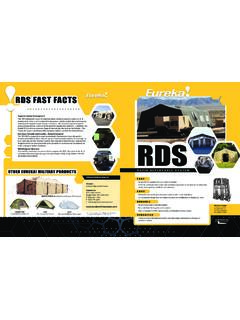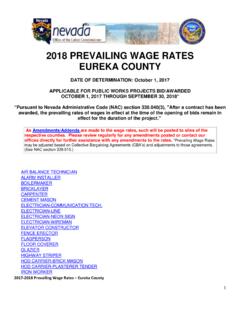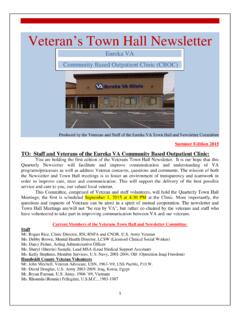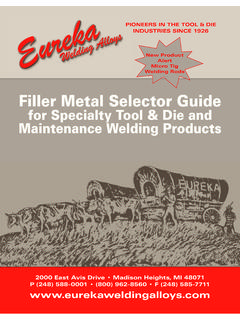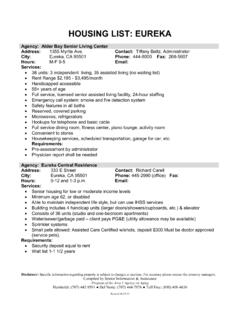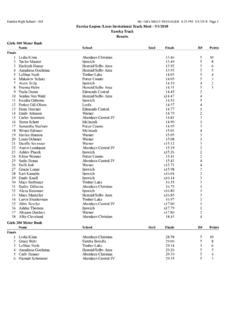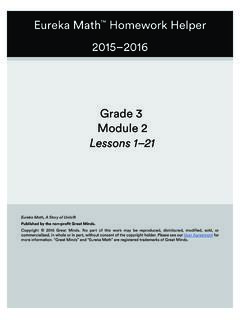Transcription of ASSEMBLY INSTRUCTIONS FOR THE TIMBERLINE and ... - …
1 ASSEMBLY INSTRUCTIONS FOR THE TIMBERLINE and TIMBERLINE OUTFITTER TENTS:Component List:1 tent Body, 1 tent Bag 4 Poles 1 Spanner 1 tent Fly, 2 Fly Rods 1 Pole Bag 2 Junction Tubes 1 Stake Bag and Stakes Unroll and unfold the tent and lay it on the ground. Remove the fly and open the tent door. Do not stake down the tent just yet; But in windy conditions, stake down one front corner into : Do not drop tent bag or pole bag on its end. Do not bounce tent bag on its end to get tent out. These actions may cut the shock cord and/or damage the pole ends. Assemble all the shock-corded poles. Make sure each pole section has firmly seated into the adjacent section.
2 Try to keep the poles from snapping together as this can damage the rod ends. Through usage, the aluminum frame may bend slightly and take a "set" this normally does not affect performance. Place the tapered end of a pole onto the diagonal hole in the junction tube. The junction tube is marked UP RT- [TOP RIGHT on TL6]- so the pole will seat at the correct angle. Insert a corner pin into the other end of the pole. See Repeat with the second pole and at the back of the tent with the last two poles and the remaining junction tube. Disconnect the rods in the middle of the spanner. Place one end of the spanner through the center hole of the first junction tube.
3 Place the opposite end of the spanner through the center hole in second Push down on the disconnected rods until they join together. This forms the free standing frame. See Connect the tent to frame by pulling the shock-corded loops, at the peaks of the tent , over the junction tubes. Snap tent clips to the : Junction tubes can be tied to the tent with the strings provided. Tie one end to the shock-cord loop. Pass the other end through the 1/8" hole in the junction tube and tie a knot. See Orient the tent in the desired location and stake it down. Fit each of the fly rods over the tip of the spanner section protruding through each junction tube.
4 Drape the fly over tent so the center S-hooks [ sewn on the underside of the fly ] line up with the rods. Insert the center S-hook into one end of the fly rod. Pull the opposite S-hook and insert it into the end of the second fly SERIES TENTS ARE EQUIPPED WITH HIGH / LOW VENTING DOORS: To allow cool air into the tent , unzip the low vent on the door and hold open with the hook and loop tab. To vent the fly, unzip the two zippers at the base of the vestibule. To allow warm, moist air to escape, unzip the peak of the door and roll down and/or the peak of the back EQUIPMENT:Annex: Front awning for storing gear and Loft: Mesh hammock attaches to rings inside the tent for drying clothes or storing Saver: Place under tent to protect the floor and keep it clean.
5 Also provides an additional moisture : Do not attempt this ASSEMBLY with the spanner joined. Connect the snaps on the underside of the fly to the rings on side of the tent . See Connect four shock-corded S-hooks, located at fly corners, to the ring and pin assemblies at base of each pole. Stake down the two pull outs on the sides of the TL6 onlyRECOMMENDATIONS: During strong winds, tie extra ropes [ not included ] to the storm rings on the fly and stake down securely. Note staking Take-down task sequence: Remove fly and open door. Disconnect hooks and peak shock-cords. Remove clips from the tent poles; then pull the pins out from the pole E outStakeStorm RingStakeGood:4 stakes /4 linesBest:4 stakes /8 linesREV E.
6 FEB 09 SEAM SEALING:We recommend use of a sealer such as Kenyon Seam Sealer 3 or McNett Outdoor SeamGrip . Work in a fully ventilated area. Set the tent up or lay the tent out flat. Taut seams allow for even application and penetration of the sealer. Decide which seams need to be sealed. For example, seams that will be exposed to rain, runoff, or ground level water are a must for sealing, while seams on uncoated nylon or mesh panels don t need treatment. There is no need to seal the seams in the roof or the factory taped seams. We recommend sealing both floor and fly seams and reinforcements. Apply sealant to the inside and outside of all exposed seams. Several thin layers will work better than one thick layer.
7 Read and follow manufacture's :All tents need to be staked down to keep them from blowing away. Securing the tent by placing heavy objects inside is just not adequate. Once the tent body is erected, stake it out before the fly is put on. This enables you to square the tent up to ensure that the fly goes on properly and that the seams align with the frame. Pull the base of the tent taut between each web stake out loop or ring & pin. Make sure that all corners are square. It is important that you don t stake the tent out too tightly. You will know it s too tight, if the door zippers can not be easily operated. Drive stakes through the web loops, or with ring & pin, drive the stake just outside the ring so that the J hook catches it.
8 Tie a piece of cord or web into a loop through the ring to be used as a large stake loop if needed. With the tent properly staked, drape the fly over the frame, attach its tent connection points and stake down any pull outs. Do not attempt to remove the stakes by pulling on the tent becket loop, as this could cause the fabric to tear. The best way is to pry on the stake in special conditions: Sand. Use long, broad stakes with plenty of surface area in loose soil. Hard, Rocky, or Frozen Soil. Steel stakes work best. Store steel stakes separately. Their sharp edges can cut fabric and leave rust stains, which might damage your tent . Snow.
9 Use dead man anchors. Tie tent to buried objects (branches, tent bags, or stuff sacks filled with snow; or tie tents to snow shoes, skis, or ski poles, which are stuck in the LINES:Do not depend upon staking alone to keep your tent secure during high winds. Most tent models have built-in loops or rings at optimal guy out locations. It s important to put in the extra time guying out your tent . Correctly done, it can save your tent during exceptional weather. Make sure that the top fly is securely attached to the tent frame. Ties, hook and loop, or dog-bones and elastic loops are sewn to the underside of the fly for this purpose. Attach parachute cord to the loops/rings and stake them in the ground three or four feet from the edge of the tent .)
10 If staked too close to the tent , wind can cause an upward pull that could dislodge the stakes. If your tent does not have loops or rings for guy outs, attach guy lines 1/3 to 1/2 of the way up the framework on the main sidewalls. This enables the guy line to support the lower section of the pole, while the upper pole can flex and deflect wind gusts. It is best to run two cords at an angle from the side of the guy out. This prevents all movement, except toward the anchor. The guy lines will work together through opposition. See illustrations below:CONDENSATION & VENTING:Through perspiration and breathing, an adult gives off about a pint of water overnight. If it cannot escape, the water vapor condenses to liquid.

